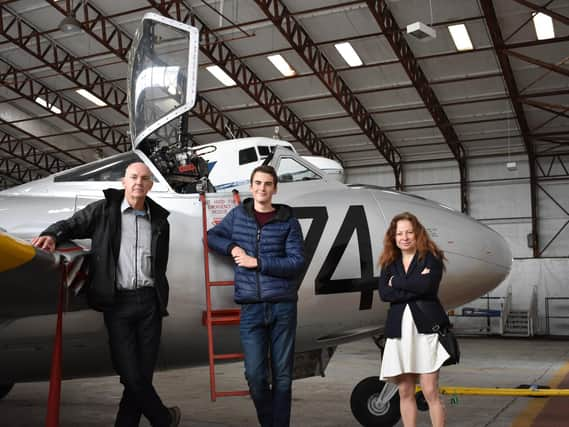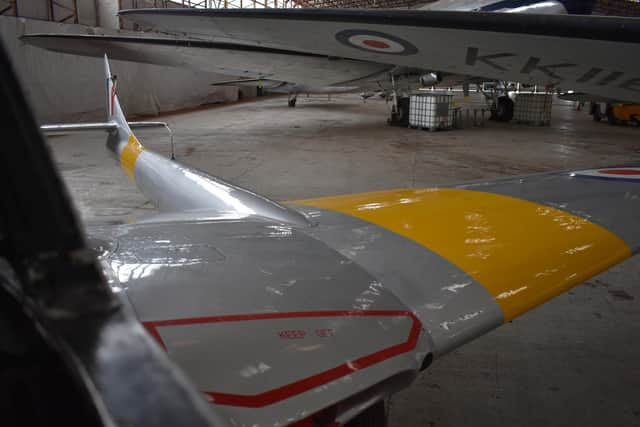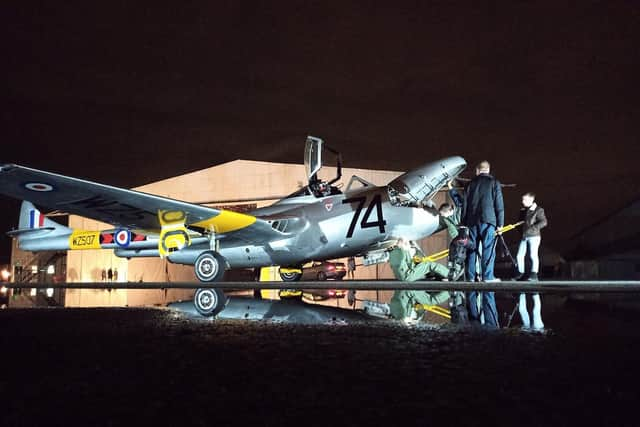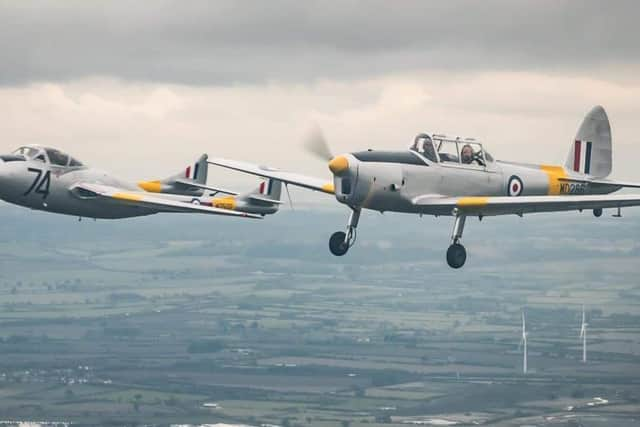We went to see the beautiful de Havilland Vampire that thundered over Rugby - here's what we found out


On Saturday, October 17, Rugbeians were transfixed when several mysterious aircraft thundered over the town.
One of them seemed to bring far more attention than the others, producing a distinct whistling sound as it passed over our rooftops.
Advertisement
Hide AdAdvertisement
Hide AdThe Advertiser got on the case and, with help from some well-informed readers, discovered that one of the aircraft was a de Havilland Chipmunk and the other, the star of the show, was a de Havilland Vampire.


We contacted the owner of the Vampire, Mark Hooton, and within days I found myself in an aircraft hangar just outside Baginton stood face-to-face or rather, face-to-nose, with the impressive fighter that caught the attention of thousands of Rugbeians.
"She could still sting if she wanted to," says Cameron Sys, a young groundcrew volunteer, pointing to the brackets designed to mount rockets and bombs and the empty space in the nose which would have housed two 25mm cannons.
"Oh, a hit from her would be like a broadside from a cruiser," adds Mark, who is originally from Australia.
Advertisement
Hide AdAdvertisement
Hide AdThe striking jet fighter in front of us looks, to a layman like me, as if it could have been built in the 1980s.


Those who know their aircraft, though, will immediately recognise this sleek, futuristic, model of fighter as having been designed and built in the era of ration books, Austin 7s and the Jitterbug.
The de Havilland vampire made its maiden flight in 1943 and entered service as the RAF's first single engine jet fighter in 1946 - just months too late to take on the remnants of the Luftwaffe in the Second World War.
And just how would it have fared against Nazi jet fighters like the Messerschmitt Me 262? Mark grinned, "the Me 262 was a far more crude affair than the Vampire."
Advertisement
Hide AdAdvertisement
Hide Ad"A lot of Spitfire pilots transferred to the Vampire after the war," Mark explained.


"The ones I spoke to loved the Vampire, they loved the visibility from the cockpit and the power.
"They used to say that one of the most dangerous times to be a fighter pilot is when you're scrambled into combat and you're trying to get off the ground.
"You need to get in the air before an enemy gets up behind you.
Advertisement
Hide AdAdvertisement
Hide Ad"With a piston-engined aircraft you have to build the speed up - with a jet you go from nothing to full power instantly."
Spitfires and Messerschmitts aside, the Vampire was exported to more than 40 countries and made a good account of itself in combat up to the late 1970s.
In the early days it was capable of flying faster and at higher altitudes than piston-engined aircraft, meaning it could zoom in, destroy ground targets and then whizz off before anything could retaliate.
Mark explained that the Vampire's longevity in combat was, in part, because it was also extremely agile, so in its later years it was prized for its ability to fly extremely low to the ground at joint-wrenching speeds.
Advertisement
Hide AdAdvertisement
Hide AdThis particular Vampire, believed to be the last operative model of its kind in the UK and possible the world, was built in 1952 and its twin seats mean it was a training aircraft.
Aircraft like the Vampire would not have been possible without the genius of Sir Frank Whittle and, in the Vampire's case, some expansion on Whittle's engine design by Frank Halford.
And Mark explained that Halford’s revolutionary work with piston engines earlier in his career was made possible in part by old Rugby firm Lodge Spark Plugs, who developed a plug whereby the spark would pass along a surface rather than between contacts.
Sitting in the cockpit is a unique experience - those familiar with MGs from the 1970s may well have some idea of the cramped conditions and the bolt-action controls, which reward the user with a mighty mechanical clunk.
Advertisement
Hide AdAdvertisement
Hide AdImpressive as the Vampire is, she, and other vintage military aircraft across the country are in an increasingly perilous position.
Mark said ever-tightening government regulations since the 2015 Shoreham Airshow crash mean the cost of keeping the Vampire alive are spiralling.
"Nowadays if you replace anything it has to be an original part - there are obvious difficulties with this because many of the factories that made these parts are long gone.
"If the generator in your car failed you know you could get a new one for £100 - the generator on the Vampire is actually quite similar - but these regulations turn it in to a £10,000 job."
Advertisement
Hide AdAdvertisement
Hide AdIt is becoming increasingly difficult to find airfields willing to host vintage jet aircraft for a variety of reasons - including noise complaints from residents.
Mark was quick to point out the irony of someone who moves next to an airfield then deciding to make noise complaints over aircraft.
The Vampire is seldom fired up, he added, and when it is they ensure that it is during sociable hours.
Part of the Vampire's preservation depends on hosting public events for photographers and residents to come along and see the Vampire's engines fired up.
Advertisement
Hide AdAdvertisement
Hide AdMark is also keen for local schools and colleges to reach out to organise trips for pupils.
"There's so much focus on STEM nowadays," he said.
"The Vampire has the power to inspire young people to pursue science and engineering. It needs your help, but it also has a lot to offer."
To counter noise complaints, Mark said he hopes any residents who enjoy the Vampire might be able to email him and explain that they think it's important the Vampire is allowed to keep running.
"We've get these noise complaints, but then it would be wonderful to be able to show just how much public support there is for keeping historic aircraft like the Vampire in the air," he said.
To learn more about the Vampire and to get in touch with Mark, visit vampireflight.co.uk